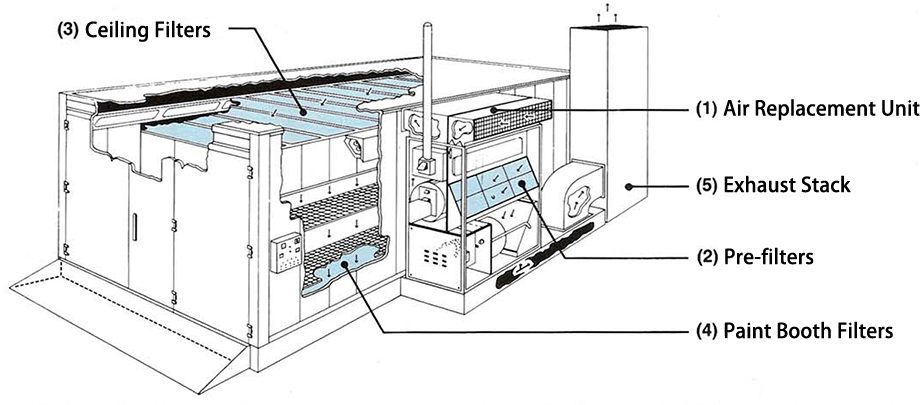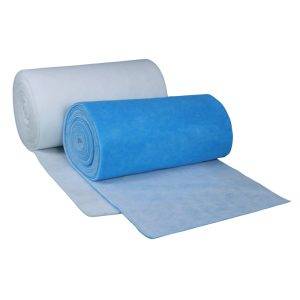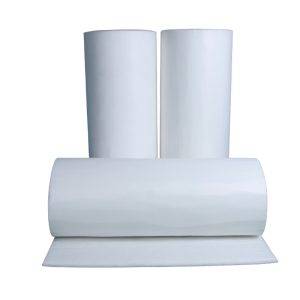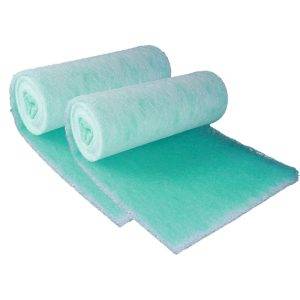Friends, imagine what it would be like if a spray painting room didn’t have an air filter? It’s just like a person without lungs, unable to breathe fresh and clean air.
The air filter is of vital importance to the spray painting room, as important as the lungs in our bodies! It can stop all the naughty dust and impurities in the air and only allow clean air to enter the spray painting room.
For example, the general painting requires that the amount of dust in the air should not exceed 7.5 per cubic meter, and the decorative painting has stricter requirements, not exceeding 4.5 per cubic meter. Without the function of the air filter, these excessive dust will mix into the paint layer and make our carefully sprayed paint uneven. That would be too bad!
Moreover, so many harmful substances and dust are produced during the spray painting process. If there is no filter to stop them, can workers stand working in such an environment for a long time?
So, the air filter in the spray painting room really deserves credit. It can not only ensure the quality of the spray painting and make our works flawless, but also protect the health of the workers and let everyone work at ease. We must not underestimate its importance!
Preparatory Work Before Construction
Measuring the Size of the Spray Painting Room
Measuring the size of the spray painting room is an important step in the construction! Measuring tools are indispensable, such as tape measures over 5 meters, cameras, laser rangefinders, etc., which may all come in handy. Traditional tape measures are troublesome to operate and prone to errors.
Laser rangefinders are much more convenient. Just shine it and the value comes out, and the accuracy is also high. If there is no floor plan, a rough floor plan has to be drawn on the spot, and just mark the data. When measuring the room, multiple methods such as measuring, observing, touching, photographing, and asking should be used.
It’s trivial but cannot be sloppy. Don’t forget to take photos for record, which is convenient for later design. If the room door is the responsibility of the manufacturer, it can save some trouble. If it’s your responsibility, the manufacturer will also review the size.
Determining the Type of Spray Painting Operations
The types of spray painting operations are mainly divided into manual spray painting and automatic spray painting. According to the types of car paint, there are alkyd paint, acrylic paint, water-based paint, etc.
Different types and varieties are applicable to different scenarios. For example, manual spray painting is suitable for small-area fine operations, and automatic spray painting is suitable for large-scale batch production. The choice must be based on specific needs and cannot be random!
Understanding the Local Air Quality
If you want to build a good spray painting room, understanding the local air quality is indispensable. Now there are many ways to understand, such as through software or platforms such as the China National Environmental Monitoring Centre.
Like in the software, first add your area, select Asia and mainland China, and then select the specific location to see the real-time air quality. If the air quality is not good, then when building the spray painting room, it is necessary to consider strengthening the air filtration system!

Key Points for Selecting Filters
Filtration Efficiency
Filtration efficiency is one of the key indicators for selecting filters. Generally, filters for spray painting rooms can be divided into primary filters, medium filters, high-medium filters, sub-high efficiency filters and high efficiency filters according to the filtration efficiency.
The efficiency of primary filters is usually G1-G3, which can filter out dust particles larger than 5μm and is mostly used as the terminal filter for general painting. The efficiency of medium filters is G4-F6 and is suitable for decorative painting.



The efficiency of high-medium filters is F6-F8 and is often used in advanced decorative painting. The efficiency of sub-high efficiency filters is F9-H11 and is mostly used in precise places such as electronics and medicine.
The efficiency of high efficiency filters is H12 and above, and is commonly used in environments such as electronics and medicine that have extremely high requirements for air quality.
For example, in a general automotive spray painting room, a medium filter can meet the basic needs; while for the spray painting operation of luxury cars, high-medium or even high efficiency filters may be required to ensure the quality of the spray painting.
Materials
The material of the filter also affects its performance and service life. Common materials include metal, non-woven fabric, artificial fiber and glass fiber, etc. Metal materials are strong and durable but have a high cost.
Non-woven fabrics have a low cost and are widely used, but the filtration effect is relatively weak. Artificial fibers and glass fibers perform well in medium and high efficiency filtration, among which the filtration effect of glass fiber is usually better, but the price is also slightly higher.
For example, for some spray painting rooms with not too high requirements for the filtration effect, the non-woven fabric filter may be sufficient; while for places pursuing high-quality spray painting effects, the glass fiber material is a better choice.
Size and Specifications
Filters with the right size and specifications can perfectly match the spray painting room. The size selection should be determined based on the size of the spray painting room and the design of the ventilation system.
There are many common specifications, such as bag filters with different models such as 592mm×592mm×600mm.
At the same time, high-efficiency air filters are also divided into partitioned and non-partitioned types, such as 320320220mm, with an air volume of 500 and an efficiency of 99.97% partitioned filter.
When determining the size and specifications, factors such as air volume, filtration efficiency and installation space should be fully considered to ensure that the filter can work normally and achieve the desired filtration effect.
Installation Steps and Skills
1.Determine the Installation Location
Friends, first of all, determine the installation location of the filter in the spray painting room. Usually, it is installed in the exhaust system of the spray painting room. When choosing the location, consider the spatial layout and air flow direction to ensure that the filter can effectively intercept impurities in the air.
For example, if the exhaust duct of the spray painting room is long, install the filter near the exhaust outlet, so that it can play its role better.
2.Select the Installation Bracket or Fixing Device
Next, according to the size and specifications of the filter, select the appropriate installation bracket or fixing device. This is like finding a suitable “seat” for the filter. If the filter is large and heavy, a strong and durable metal bracket should be selected; if the filter is relatively small, a plastic or light metal bracket may be sufficient.
3.Install the Bracket or Fixing Device
After selecting the “seat”, install the bracket or fixing device at the appropriate position in the spray painting room. Ensure that it is firmly and stably installed when installing, and tools such as screws and rivets can be used for fixation. Remember to check it again to ensure there are no loose places.
4.Place the Filter
Then, carefully place the filter on the bracket or fixing device. Be careful! Be sure to handle it with care to avoid collision and damage to the filter. After placing it, confirm again whether the filter is stable.
5.Connect the Pipeline
Finally, it’s time to connect the filter to the exhaust system of the spray painting room! This step cannot be sloppy. Before connecting, ensure that the pipeline is clean and free of impurities, and then use the appropriate connectors and sealing materials to ensure a tight connection without air leakage. After connecting, you can also gently shake it by hand to check if it is firm.
During the entire installation process, there are some tips to tell you. For example, carefully read the manual of the filter before installation to understand the precautions; wear gloves during installation to avoid dirtying the filter; after installation, do not rush to use it, conduct a test to see if the filter is working properly. In this way, we can successfully complete the installation of the air filter in the spray painting room!
Inspection and Debugging After Installation
Inspection of Installation Firmness
Checking whether the filter is firmly installed is an important link related to the subsequent use safety and effect. Friends can conduct a manual check first, gently shake the filter to see if there is obvious looseness. Then use tools, such as wrenches, to check whether the fixing screws are tightened. At the same time, check whether the installation bracket or fixing device is deformed or damaged.
For example, when checking a large spray painting room filter, it was found that there was a slight shake when manually shaken. After further tightening the screws with a wrench, the firmness was guaranteed.
Air Leakage Inspection
The air leakage inspection cannot be sloppy either. First, the observation method can be used. When the filter is running, check whether there is abnormal air flow around it. Touch the edge of the filter with your hand to feel if there is obvious air flow. You can also listen to the sound. If there is a “hissing” sound, there is likely an air leakage. If possible, use a dedicated air leakage detection device for more accurate detection.
For example, in the inspection of a certain spray painting room, a suspected air leakage point was found by listening to the sound, and it was processed in time after being confirmed by a dedicated device.
Debugging Method
The debugging work is the key to making the filter reach the best working state. First, ensure that the filter operates within the rated wind speed range and observe whether its working state is stable. Then, adjust the relevant parameters such as air volume and pressure according to the type of the filter and the manufacturer’s instructions.
For example, during the debugging of a medium efficiency filter, the best working point was found by gradually adjusting the air volume, and the filtration effect was significantly improved.
During the debugging process, pay close attention to the various indicators of the filter to ensure its normal operation. Only through careful inspection and debugging can the air filter of the spray painting room exert the best performance and provide us with a high-quality air environment for our spray painting work.
Daily Maintenance and Care
Regular Cleaning
Friends, the air filter of the spray painting room is like our beloved car. Regular cleaning is very important! For primary and medium filters, if the surface is not very dirty, we can take them outdoors and blow and wash them on both sides with clean compressed air until no dust particles can be seen in the light with the eyes.
If the surface is very dirty, it needs to be washed with water. Put about 100 pounds of drinking water in a tank in the water production room (air conditioning room) in the general area, dilute 1 pound of bottled detergent, put the filter in and submerge it completely, rinse several times until there is no stain, and finally rinse it with clean water.
Take it out and leave it to dry in the air on a stainless steel grid mop, and then lay it flat on the shelf to dry. Remember to turn it frequently on both sides to speed up the drying process.
Regular Replacement of Filter Elements
The filter element also has a service life and cannot be used all the time. Generally, primary and medium air filters usually need to be replaced after about 2 months of use. If the replaced filter material is not too dirty, it can be placed in water and washed with detergent, but be careful that it must be replaced after rinsing twice.
For drying, choose natural air drying and do not expose it to the sun. For high efficiency filters, when the pressure difference exceeds 450Pa and the air flow speed on the air outlet side drops to the minimum, it may need to be replaced.
Daily Inspection
We also need to pay more attention to the condition of the filter in daily life. For example, see if there is a pressure difference gauge or pressure difference sensor before and after the filter. If the pressure difference of the coarse filter is greater than 250Pa, the pressure difference of the medium filter is greater than 330Pa, and the pressure difference of the sub-high efficiency filter is greater than 400Pa, it should be replaced in time, and the original filter cannot be reused.
Clean the Surrounding Environment
Don’t just focus on the filter itself, the surrounding environment also needs to be kept clean. Use a rag to thoroughly clean the outer surface of the air conditioning box and the attached pipelines and instruments every day to make the equipment clean and bright.
For the interior of the air conditioning system, after each replacement of the primary and medium filters, the fan, wall panel, cooler, heater and diffuser plate inside the air conditioning unit should be thoroughly cleaned, wipe off dirt, dust and oil stains, leaving no dead corners.
In conclusion, only by doing these daily maintenance and care work well can our spray painting room air filter work stably for a long time and escort the spray painting quality and working environment for us!
Common Problems and Solutions
Poor Filtration Effect
During the construction and use of the air filter in the spray painting room, sometimes the filtration effect may be poor. This may be due to improper selection of the filter, such as choosing a filter efficiency level that is too low to effectively intercept impurities in the air.
The solution is to re-select a filter with the appropriate filtration efficiency level according to the actual needs of the spray painting room, such as upgrading from the primary filter to the medium or high efficiency filter.
It may also be that the filter has been used for too long, and the filter element is clogged or damaged. At this time, the filter element should be cleaned or replaced in time.
It may also be that the installation is improper, resulting in the air entering the spray painting room without effective filtration. This requires re-checking the installation steps to ensure that the filter is installed correctly and sealed well.
Noise
The noise problem is also one of the common troubles. If the fan of the filter itself fails, it may produce abnormal noise. At this time, it is necessary to contact professionals for maintenance or replacement of the fan.
If the installation position of the filter is unreasonable and resonance occurs with surrounding objects to produce noise, then the installation position needs to be adjusted to avoid resonance.
In addition, loose internal components of the filter may also cause noise. The filter needs to be inspected and loose components tightened.
Frequent Damage of Filters
Frequent damage of the filter may be due to the excessive dust concentration in the spray painting room, which exceeds the bearing capacity of the filter. At this time, it can be considered to add a pre-filter device at the front end of the filter to reduce the burden on the filter.
It may also be that the quality of the filter is not up to standard. It is recommended to select reliable products.
At the same time, it is necessary to check whether the ventilation system of the spray painting room is normal to avoid damage to the filter caused by excessive or unstable wind speed.
Insufficient Air Flow
When insufficient air flow is found, it may be that the filter is seriously clogged and needs to be cleaned or replaced in time.
It may also be that there is clogging or air leakage in the ventilation duct. The duct should be inspected and cleaned, and the air leakage points should be repaired.
In addition, fan failure may also lead to insufficient air flow, and the fan needs to be inspected, repaired and maintained.
In conclusion, don’t panic when encountering these common problems. Analyze the reasons calmly and take corresponding solutions to make the air filter of the spray painting room work normally and provide a good environment for the spray painting operation.

